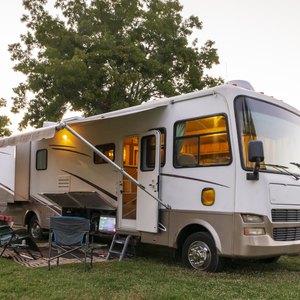
Taking over the payments on someone’s recreational vehicle isn’t as simple as agreeing to make the remaining RV or camper payments with the current owner’s permission. You’ll almost always need permission from the lender to take over the loan or lease, and whether or not they will let you will depend on the type of contract the current owner has, and what type of creditworthiness you have.
In addition, the current owner might want cash to cover the money he’s already put into the vehicle if it’s a loan, rather than a lease. Reviewing the process of taking over the remaining costs of someone else’s RV will help you decide if this is a good deal for you, and if you can even do it.
What Is "Taking Over" RV Payments?
When you “take over payments” on a loan, you’re not simply writing the checks or having the monthly payment drafted from your bank account. You must take over and become responsible for the loan. This allows the current borrower to walk away from the loan or lease, the payments and the vehicle altogether.
In some cases, the RV owner just wants to get out of a loan, even if she’s already made most of the payments. You agree to assume the loan or lease, make the remaining payments and take all responsibility for the contract’s terms. The terms will include things like maintaining the required insurance on the RV and making payments on time. Once you finish making the payments, the RV is yours.
Responsibilities After a Loan Assumption
Sometimes, the person who is asking you to take over the payments is actually giving you an opportunity. He has made most of the payments and you only have to pay off a partial amount of the loan or lease. Depending on the amount the original borrower has already paid, he might want some cash before he gives you the opportunity to finish the loan payments and take possession of the RV.
In this scenario, you’ll want to know your total cost of the remaining loan or lease and what its value will be at the end of the contract. If you’ll pay $30,000 of the remaining loan and the current owner has already paid $100,000, the current borrower will usually take less than $100,000 because the vehicle has depreciated in value.
If you plan on selling the RV after you’re done with the loan, go online and see what its projected resale value will be after you finish your loan contract. If you want to keep the RV for years after you pay it off, do some calculations to determine what that is worth to you – you could just buy a new RV at that time, instead, which might be a better deal or might cost too much.
Taking Over Vehicle Payments
The first step in taking over RV or camper payments is to find out if the borrower has an assumable loan or lease. An assumable loan is one that allows the borrower to transfer the loan to someone else, explains Gone Outdoors. The lender still usually has to approve the new borrower, so you’ll have to pass a credit check with the lender.
Most people do not have assumable vehicle loans, so you will probably need to apply with the lender to take out a new loan on the remaining amount. You might also not get the same interest rate on the new loan the original borrower got, so the monthly payments might go up.
Have the original borrower contact her lender to find out what the process is for having you take over the loan or lease. Follow the directions the lender provides, which will include allowing the lender to pull one or more of your credit reports. If you haven’t checked them for accuracy lately, visit AnnualCreditReport.com to see if you need to clean up your reports. That can take 30 days or longer.
Submit the paperwork required to assume/transfer the loan or lease and sign all of the documents. This will include having the registration and title transferred to you as part of the deal. You’ll need to make sure to have the RV inspected before you sign any papers to make sure the original borrower isn’t selling you a damaged vehicle.
Making Informal RV Payment Arrangements
Let’s say your parents have an RV with two years’ worth of payments left but are struggling financially. You agree to give them the money for those remaining 24 payments, but their names are still on the loan. You can have them switch the payments to come from your credit card or bank account. You might do this as a favor and let them keep the RV when it’s paid off, or you get the RV at some point in the future.
There’s no loan paperwork involved in this type arrangement, but you should put any side deals like this in writing with the other party. As far as the lender is concerned, your parents are still the borrowers, they hold the registration, they get the title when the loan is paid off and they are responsible for all payments and any consequences (like a dinged credit score, repossession, fees and fines) if you don’t make the payments.
References
Writer Bio
Steve Milano has written more than 1,000 pieces of personal finance and frugal living articles for dozens of websites, including Motley Fool, Zacks, Bankrate, Quickbooks, SmartyCents, Knew Money, Don't Waste Your Money and Credit Card Ideas, as well as his own websites.

